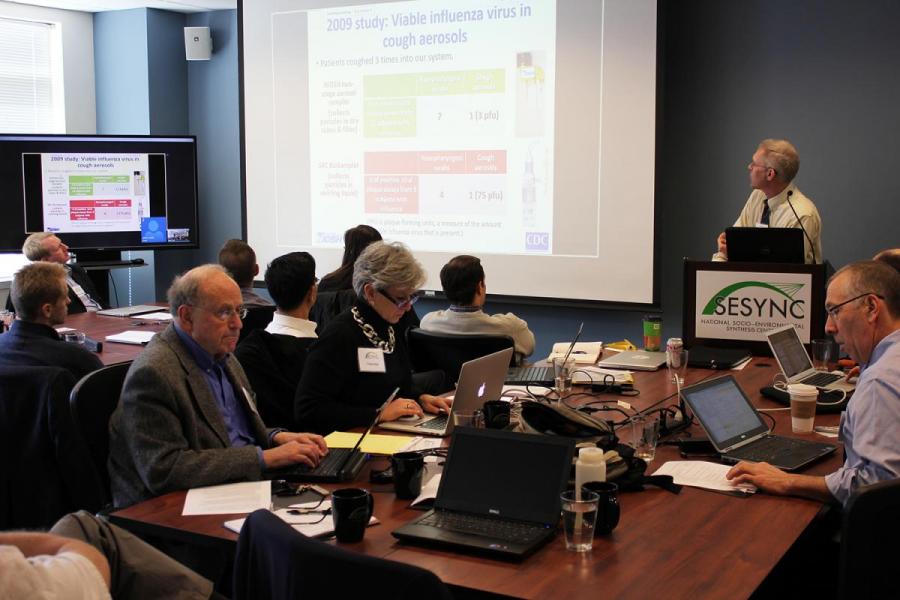
It’s late January, and you’ve just arrived at the office. That chatty, suspiciously cheery coworker of yours has you cornered by the coffee machine. It’s first thing in the morning, so your escape reflexes are muted. How was your weekend?, he wants to know. His was great. He was at the hockey game. His team won. But it was cold, he forget to wear gloves, and now he’s not feeling so well.
And then … it happens. He sneezes.
Welcome to flu season.
Many experts think that influenza, commonly referred to as “the flu,” is spread by large-particle droplets made when infected persons talk, cough, or sneeze. These droplets don’t remain suspended in the air, so in order for the virus to spread, close contact between source (e.g., your gabby coworker) and recipient (e.g., you) is required. Droplet transmission begets the recommendations of “cover your mouth” and “wash your hands.” But is that really enough to curb the spread of influenza?
Depending on who you ask, it’s a good start—but not nearly enough. Some researchers disagree that droplet transmission is the only, or even primary, means of passing the flu from one person to another. These experts stress the significance of airborne transmission: small droplets or dust particles containing the flu virus that remain suspended in the air, and can therefore be dispersed widely by air currents.
Yet without consensus on the respective roles of droplet and airborne transmission, it’s difficult to design comprehensive and consistent protocols for flu prevention. That’s a concern, says Dr. Donald Milton, Professor of the University of Maryland’s School of Public Health, for obvious reasons. He notes that despite evidence supporting airborne transmission’s role in spreading the flu, planning for airborne precautions has been ineffective—because we don’t actually agree that it needs to be done in the first place.
“Right now,” Dr. Milton says, “in the case of an influenza pandemic, day cares, public schools, and universities plan to shut down and send everybody home. That’s a huge disruption with significant economic impacts and questionable effectiveness. And where do kids go when you shut down the schools? They hang out in malls. Does that really buy you any protection?”
A primary goal of airborne precautions, he says, is to make schools, malls, and all other buildings safe places to be during a pandemic, to the benefit of both public health and the local economy. How? The right ventilation system can actually reduce rates of airborne illnesses, including the flu. It’s this goal that served as an impetus for a recent workshop hosted at SESYNC focused on how we design, build, operate, and maintain built facilities from a pandemic perspective.
Led by Dr. Milton and co-principal investigator Dr. Jelena Srebric, Professor of the University of Maryland’s A. James Clark School of Engineering, the workshop brought together a diverse community of experts thinking about and working on questions related to flu transmission. Participants included a biostatistician investigating non-pharmaceutical interventions for reducing influenza transmission. The director of a university health center. A medical anthropologist studying the relationships between the everyday lived experiences of individuals and communities and the biopolitics of global health institutions. The director of a federal research grant program. A top administrator from university residential facilities. The director of a federal program focused on occupational health and infection control challenges. A computer scientist researching algorithms in networking phenomena. An engineer focused on multi-scale modeling of built infrastructure and assessing how these systems affect energy consumption.
Along with 30 other workshop attendees, these experts comprised a mosaic of perspectives uniquely positioned to investigate the question of influenza transmission and the built environment. A key effort of the workshop included synthesizing existing studies that point toward the big role of small droplet transmission (and by virtue, of ventilation systems) in the spread of influenza. Despite these studies, we don’t have a body of work that convinces everyone. Part of the group’s challenge, therefore, was to determine what it would take to reframe our perceptions of transmission.
Spoiler: it’s not going to be easy, particularly given the breadth of communities to be reached. Researchers, funding agencies, decision makers, and engineers are all integral to prioritizing pandemic preparedness in facilities planning.
“Even though building ventilation systems are known to increase or reduce an individual’s risk of influenza exposure,” says Dr. Srebric, “that factor is largely ignored in practice. It’s like a non-existent problem, or at least we [engineers] think the problem doesn’t belong to us, because we’re not obligated by standards or codes to consider it as relevant.”
Fueled by the conversations and insights of the workshop, the group is developing a white paper that describes the current climate, as well as research necessary to move the needle toward healthy and sustainable buildings. The paper will be an interdisciplinary effort that integrates fundamental research needed to identify the principle mode of transmission, as well as applied research needed to design these buildings.
“Thanks to the truly wonderful combination of people and expertise we have working on this project,” Dr. Milton says, “we can get at this problem better than anybody else.”
Learn more about the workshop here.
This workshop was funded under a call for proposals targeting University of Maryland (UMD) faculty. The call was co-supported by the university’s Office of the Provost, the Division of Research, and the deans of multiple colleges (CMNS, AGNR, BSOS, ARHU, ENGR, and JOUR).